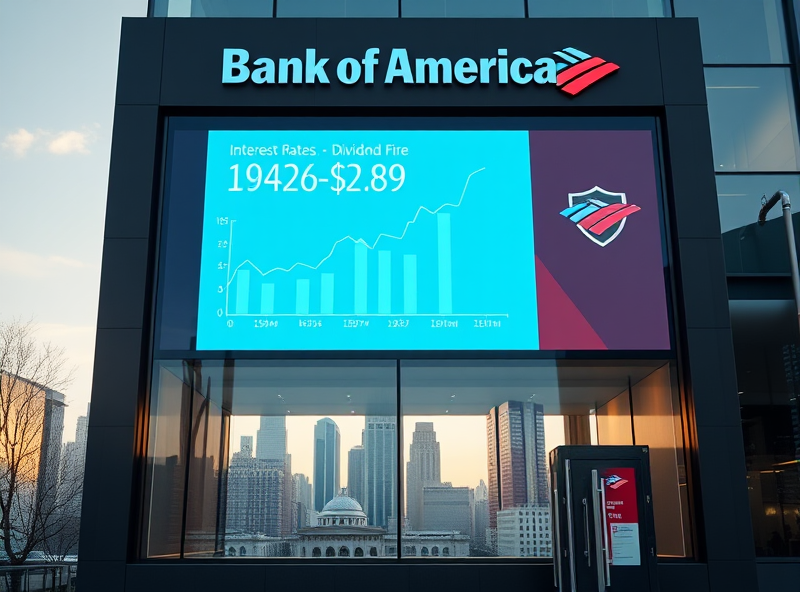
Bank of America Stock Outlook 2025: Rates, Risks & Rewards
How Interest Rate Dynamics Shape Bank of America’s Profitability

Interest rates play a pivotal role in determining the profitability of banks, and Bank of America (BoA) is no exception. As we look ahead to 2025, understanding how rate changes influence BoA’s earnings can offer valuable insights for investors and consumers alike.
When interest rates rise, banks typically benefit from a wider net interest margin (NIM)—the difference between what they earn on loans and what they pay on deposits. For Bank of America, which has a large base of interest-earning assets like mortgages and commercial loans, a higher rate environment often translates into increased revenue. In fact, during the Federal Reserve’s rate hikes in 2022–2023, BoA reported significant gains in net interest income.
However, rising rates also come with risks. Higher borrowing costs can reduce loan demand and increase default rates, especially in sectors like real estate and small business lending. Additionally, rate volatility can impact BoA’s bond portfolio and investment strategies, leading to potential mark-to-market losses.
Conversely, in a declining rate environment, BoA may face pressure on its margins. While lower rates can stimulate loan demand, they also compress NIM and reduce profitability. The bank must then rely more heavily on fee-based services and cost-efficiency measures to maintain earnings.
Looking toward 2025, the Federal Reserve’s monetary policy will be a key determinant of BoA’s performance. If inflation stabilizes and rates plateau or decline, BoA may need to adapt its strategy to protect margins. On the other hand, if rates remain elevated, the bank could continue to benefit—provided credit quality remains strong.
In summary, interest rate dynamics are a double-edged sword for Bank of America. Investors should closely monitor macroeconomic indicators and Fed policy signals to anticipate how these shifts might affect the bank’s bottom line.
Source: https://www.federalreserve.gov/monetarypolicy.htm
How Interest Rate Dynamics Shape Bank of America’s Profitability

As we look ahead to 2025, one of the most critical factors influencing Bank of America’s (BAC) stock outlook is the trajectory of interest rates. Since BAC generates a significant portion of its revenue from net interest income—the difference between what it earns on loans and what it pays on deposits—interest rate movements directly impact its profitability.
If the Federal Reserve maintains higher interest rates to combat inflation, BAC could benefit from wider net interest margins. This scenario would likely support stronger earnings, especially if loan demand remains steady. However, persistently high rates could also dampen consumer borrowing and increase credit risk, which may offset some of the gains.
Conversely, if rates begin to decline in 2025 due to economic slowdown or easing inflation, BAC might face margin compression. Lower rates typically reduce interest income, although they may also stimulate loan growth and reduce default risks, creating a mixed impact on the bank’s bottom line.
Analysts are currently divided. Some forecast BAC stock to reach $40–$45 by the end of 2025, assuming stable economic conditions and moderate rate cuts. Others are more cautious, citing potential recession risks and regulatory pressures that could weigh on performance.
Investors should closely monitor Federal Reserve policy updates and macroeconomic indicators, as these will be key drivers of BAC’s earnings trajectory. For a deeper look into rate expectations, the Federal Reserve’s Summary of Economic Projections is a reliable source: https://www.federalreserve.gov/monetarypolicy/fomcprojtable.htm
How Interest Rate Dynamics Shape Bank of America’s Profitability

As we look ahead to 2025, Bank of America’s (BAC) stock outlook is closely tied to the broader economic landscape—particularly interest rate trends and macroeconomic shifts. Interest rates directly influence the bank’s core business model, which relies heavily on net interest income (NII)—the difference between interest earned on loans and interest paid on deposits. When rates rise, banks like BAC typically benefit from wider spreads, boosting profitability. However, the Federal Reserve’s rate trajectory in 2025 remains uncertain, with inflation pressures and economic resilience playing key roles.
Earnings strength is another critical factor. Bank of America has demonstrated resilience through diversified revenue streams, including wealth management and investment banking. But with economic uncertainty, earnings volatility may increase. Slower loan growth, higher credit loss provisions, and potential regulatory changes could weigh on performance.
Investors should also consider the risk-reward balance. While BAC’s strong capital position and cost-cutting initiatives offer upside potential, stock volatility could remain elevated amid shifting economic signals. Staying informed about Fed policy, inflation data, and quarterly earnings reports will be essential for making smart investment decisions.
For more insights, you can explore the Federal Reserve’s latest economic projections here: https://www.federalreserve.gov/monetarypolicy.htm
How Interest Rate Dynamics Shape Bank of America’s Profitability

Bank of America (BAC) has long been a cornerstone of the U.S. financial system, and as we look toward 2025, investors are closely watching how interest rate fluctuations will affect its dividend stability and capital resilience. In an environment where the Federal Reserve is expected to maintain higher-for-longer interest rates, banks like BAC face both opportunities and challenges.
Higher interest rates generally benefit banks by widening net interest margins—the difference between what banks earn on loans and what they pay on deposits. For Bank of America, which has a large base of low-cost deposits, this can significantly boost profitability. In fact, during the recent rate hike cycle, BAC reported stronger earnings due to improved net interest income.
However, the flip side is that higher rates can also increase credit risk. Borrowers may struggle to repay loans, especially in sectors like commercial real estate or among subprime consumers. This can lead to higher loan loss provisions, which may pressure the bank’s capital reserves.
Despite these risks, Bank of America has demonstrated strong capital resilience. As of Q1 2024, the bank maintained a Common Equity Tier 1 (CET1) ratio well above regulatory requirements, reflecting prudent risk management and a solid balance sheet. This capital strength supports the sustainability of its dividend, which is a key concern for income-focused investors.
Moreover, BAC’s consistent dividend payouts—even during volatile periods—signal management’s confidence in the bank’s long-term earnings power. For those considering BAC as a dividend stock for 2025, the combination of strong capital buffers and interest rate tailwinds makes it a potentially rewarding, albeit not risk-free, investment.
For further insights, you can refer to the Federal Reserve’s interest rate policy updates: https://www.federalreserve.gov/monetarypolicy.htm






